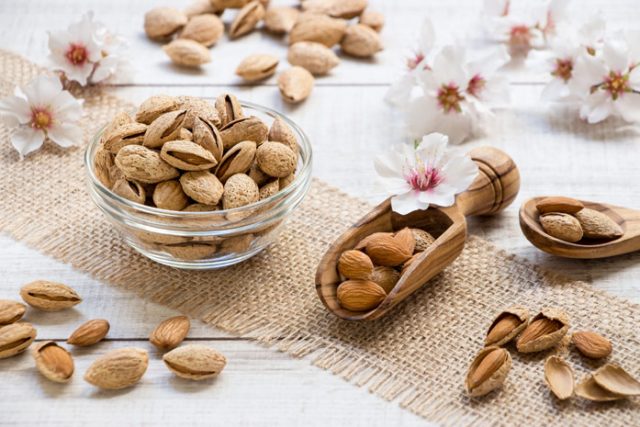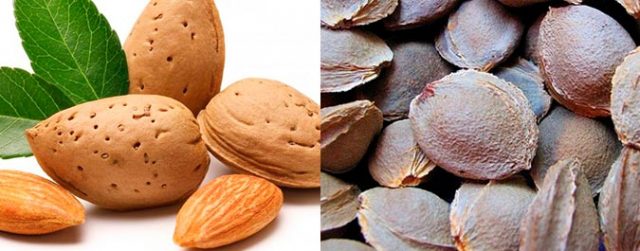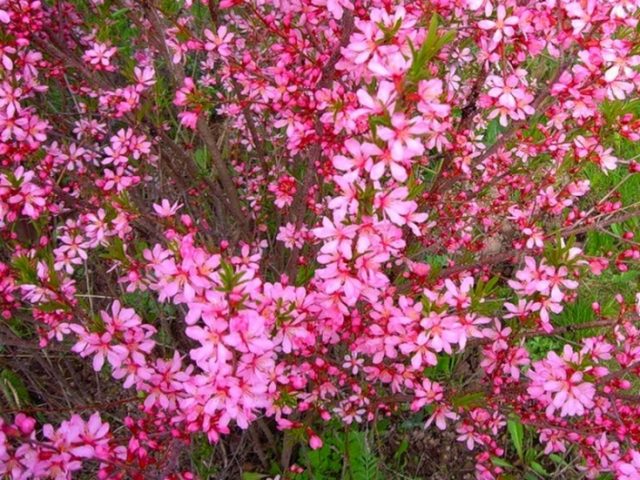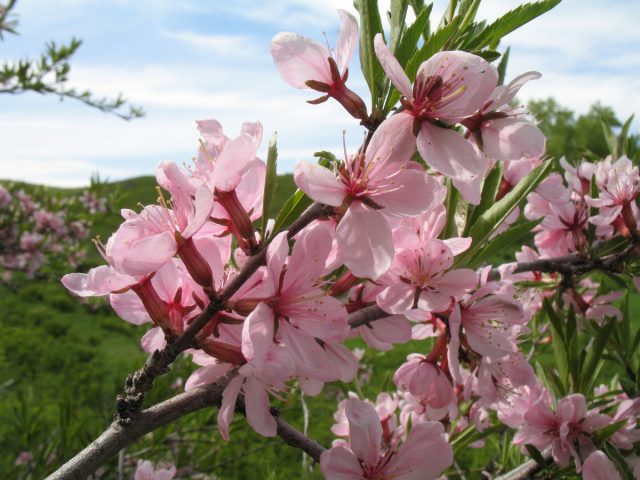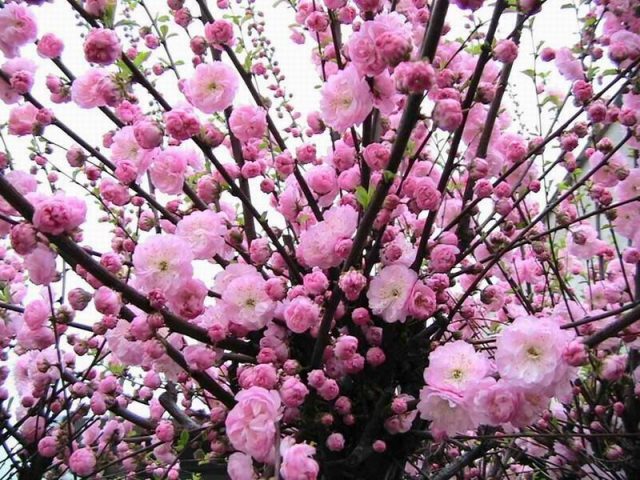Content
As soon as the word "almond" sounds, some represent tasty nuts of a characteristic shape, others - a small tree covered with a cloud of pale pink flowers. Children know Raffaello sweets, and adults know Amaretto liqueur, an indispensable ingredient of which is the aromatic kernel of the stone, which is not actually a nut. Unfortunately, almonds do not grow everywhere. Our only edible species is cold, but through the efforts of breeders, the culture is gradually mastering cool regions.
Almonds are apricot pits or not
Some believe that the kernels of apricot kernels are almonds. This is a delusion, and a dangerous one. Apricot pits, like almond pits, contain amygdalin, which releases hydrocyanic acid when cleaved. True, the concentration of poison in the nucleus is low, and during heat treatment it significantly decreases, but it can still harm the body, especially children.
Apricots are grown because of the juicy fruits, the seeds are supposed to be thrown away before use. Therefore, the selection is aimed at breeding varieties with various characteristics of the pulp, and no one is involved in reducing the concentration of cyanide compounds in the kernel. It is enough that they do not become fruit.
Almonds, as a fruit tree, are planted exclusively to obtain seed kernels, mistakenly referred to as nuts. Over the millennia of selection, the concentration of amygdalin in them has been minimized.
It is impossible to confuse apricot and almond pits. In the latter, it looks like a peach one, although it is usually smaller in size, and is covered with deeply depressed dots, strokes. If you compare the pits of apricot and almond in the photo, the difference is clearly visible:
Where do almonds come from?
The subgenus Almond belongs to the genus Plum of the Pink family and consists of 40 species. Only one of them is edible - Common Almond (Prunus dulcis). It is his cultivated trees that give seeds, the kernels of which are eaten. They are called almonds, and although this, from a botanical point of view, is incorrect, the name stuck.
Species trees give seeds with bitter kernels containing a large amount of amygdalin (2-8%). They are widely used in the perfumery industry and for the manufacture of medicines, only a small part is used by the food industry to impart a characteristic taste and aroma to products.
The kernels of the seeds of a specific plant are usually called bitter almonds (Prunus dulcis var. Amara). They are sometimes considered inedible, but they are not. Bitter almond kernels can be eaten, however, in small quantities. It is believed that the lethal dose for children is 5-10 "nuts", for adults - 50. But considering that even sweet almonds are recommended to eat no more than 10 kernels a day, everything turns out to be not so scary. In addition, heat treatment significantly reduces the concentration of amygdalin in the bones.
Cultivars that have been bred for thousands of years and aimed at reducing bitterness are called sweet almonds (Prunus dulcis var. Dulcis). The concentration of amygdalin in it does not exceed 0.2%. It is these seeds, or kernels peeled from the shell, that are sold in markets and supermarkets.
Based on this, we can conclude that edible almonds are divided into two groups:
- bitter, that is, a specific plant and its forms;
- sweet - artificially bred varieties with a kernel containing a low concentration of amygdalin.
Where do almonds grow?
Common almonds have been cultivated for so long, and the crop itself has proven to be so attractive for cultivation in hot arid climates that scientists can only guess where it comes from. Most botanists agree that the primary focus of the appearance of the species falls on Asia Minor. The almond tree is mentioned in the Bible, from later sources it should be noted "The Book of a Thousand and One Nights", the roots of which go back to ancient times, and the origin has not yet been clarified.
Cultural plantings of trees covered the territory of Ancient Greece and Rome in the Mediterranean, Tunisia, Algeria, Morocco in Africa. In the Fergana Valley, there is the "city of almonds" Kanibadam (Tajikistan). In addition to the Central Asian countries - Uzbekistan, Kyrgyzstan and Tajikistan, the culture is widespread in Armenia, Dagestan and Georgia, where trees came from Persia, in China, Iraq, Turkey and Afghanistan.
Today, almond trees are grown in Chile and Australia, in Central and Asia Minor, southern Europe and northern Africa. But the largest industrial plantations are in the state of California. It is the United States that is the world's largest exporter, where in 2018 the production of kernels reached 1.1 million tons, and the supply to the external market - about 710 thousand tons. Spain, Iran, Italy, Morocco and Syria are closely behind them.
Sweet almond trees grow in the Caucasus and Crimea. All 8 varieties included in the State Register were created in the Nikitsky Botanical Garden. The selection is aimed at breeding trees that can withstand low temperatures, return frosts and soil moisture exceeding the usual for the crop.
Decorative trees
Besides edible varieties, there are ornamental trees and shrubs. They also love warmth, but can grow in regions with a much harsher climate. For use in landscape design, varieties are derived by crossing with Common Almonds such types:
- Steppe, Low or Bobovnik grows naturally in Southeast and Central Europe, Western Siberia and Central Asia. It can be cultivated near Vologda and St. Petersburg.
- Georgian - promising for landscaping, less frost-resistant than the previous one, species, endemic to the Caucasus. It can grow in the Moscow and Leningrad regions.
- Ledebour, the area of which is the foothills of Tarbagatai and Altai. Has shown sufficient frost resistance in Belarus, Moscow and Leningrad regions. Often used to create varieties and hybrids.
- Petunnikova - a fairly winter-hardy endemic of the western Tien Shan. Grown in Western Siberia, Central Asia, Moscow, Kiev, Voronezh.
- Three-bladed or Luiseania Three-bladednative to North Korea and China, it is most commonly grown as an ornamental tree. This species tolerates moderately frosty winters quite well without sudden temperature changes. It can be grown under cover even in the Northwest.
Photo of a blooming three-lobed almond variety Rosemund
What does an almond look like
The subgenus Almond includes low deciduous trees up to 10 m in height and shrubs no more than 6 m in height. The culture is distinguished by abundant attractive flowering, as well as fleshy mesocarp, which often dries out after kernel maturation.
The greatest economic importance is the Common Almond, which gives edible fruits and participates in the creation of decorative varieties. The botanical description of the plant does not exactly repeat all the features of other species, but will give an idea of the culture as a whole.
What an almond tree looks like
Common almond forms a tree 5-6 m high.In favorable conditions, it is able to reach 10 m.Some specimens, for example, a two-hundred-year-old (usually trees live no more than 130 years) almonds from the Crimean Cape Ai-Todor have grown to 15 m.
The bark of an adult tree on a trunk and old branches is gray-brown, covered with vertical cracks, young trunks are dark gray, smooth. Annual growth is greenish-gray, reddish on the sunny side. Many young branches branch off at right angles from the trunk, making the tree appear thicker than it actually is. Depending on external conditions, the shape of the crown can be spreading, pyramidal and even weeping.
Vegetative (producing leaves) buds with a sharp tip, generative (fruit) - rounded, covered with fluff. First, in March-April, pink flowers open, only then elongated-lanceolate green leaves with a silvery bloom appear.
The root system of the almond tree is powerful, but weakly branched. The culture forms several strong shoots that penetrate several meters deep (in natural conditions - up to 4-5 m) and is practically devoid of fibrous formations. This root structure allows the tree to survive in arid mountainous areas.
What almond fruits look like
The fruits of almonds are not nuts at all, but drupes with a maximum length of 6 cm.The weight of the kernel can reach 5 g, but in most varieties it does not exceed 3 g. Green almonds are covered with an inedible velvety pericarp, which dries out after the ripening of the stone about 3 cm in size, shrivels and cracks ... In doing so, the fruit often peels off and falls to the ground.
The almond stone has a characteristic shape - oblong, asymmetrical, with a pointed tip, with a deep depressed stripe along one edge. It can be more or less elongated, rounded, flattened, or nearly cylindrical. The shell of the stone is from yellowish-gray to dark brown, dense, rough, lumpy, mottled with deep pits and grooves.
The core is covered with wrinkled skin of brown shades. At the break it has a white color with a cream shade. The shape of the kernel follows the outline of the shell. Almond seeds are divided into four groups:
- paper-shell - nuts are easy to crush with your fingers;
- soft-shell - the core is easy to reach with forceps;
- dense-shell - nuts are choked with tongs if you make an effort;
- hard shell - the core can only be removed with a hammer.
The seeds or trees of sweet and bitter almond varieties are almost impossible to visually distinguish from each other. But usually (though not always) the shell of the latter is hard, and the kernel has a strong characteristic odor. But the taste of bitter and sweet almonds is easy to distinguish.
Most often, fruiting begins in the 3-4th season after planting, reaches a maximum by 20-30 years, sharply decreases after 50-65 years. A mature tree can produce 6-12 kg of peeled kernels per season. The seeds are harvested, depending on the ripening period, from July to September.
How almonds bloom
Blooming almond branches have been sung by generations of oriental poets, they were immortalized on his canvas by Van Gogh. Indeed, the many opening buds that surround the tree with a pink or white cloud in early spring look magical.
They appear in March or April, rarely - by the end of February, before the leaves open. Large flowers, in Common Almond, are pale pink, with five petals, symmetrical, single, up to 2.5 cm in diameter. The calyx is bell-shaped, the stamens are from 15 to 30, the pistil is one.
The flowering of specific almonds is very beautiful, but decorative varieties and hybrids are much more impressive. Residents of regions with a warm and temperate climate rarely see fruit-bearing trees - they need real heat and warm, without recurrent frosts, spring. But there are many decorative varieties with double or simple flowers that are hardy enough to grow in the Leningrad region, Primorsky Krai and Western Siberia.
How almonds grow
In the photo of almond bushes growing in natural conditions, it can be seen that they are located one by one or in few groups. Culture never forms an overgrowth. This is due to the fact that almonds have high lighting requirements and do not like compacted plantings.
The California plantation, taken from a bird's eye view, allows you to see that the trees grow freely, a significant gap is left between their crowns. This is the only way to get a substantial harvest.
But almond trees have low requirements for soils. This does not mean that they will grow anywhere. Almonds prefer light clays or loams, but they will also take root on carbonate or leached chernozems. Trees feel good on rocky slopes, sheltered from the north wind.
The culture easily withstands drought, but it may not stand heavy rains or watering. The almond tree can survive frosts down to -25 ° C, but a drop in temperature during or after flowering will cause the ovary to fall off.
Interestingly, seedlings and young trees are in no hurry to shed their leaves. They crumble after the New Year or after the temperature drops to -8 ° C. But fruit-bearing trees in August may be left without leaves, but with nuts. What is noteworthy is that green almonds do not crumble at the same time - there is enough culture for the ripening and further vegetation of chlorophyll contained in the pericarp.
Conclusion
Almonds grow, producing edible kernels, in hot, dry climates with predictable warm springs. But through the efforts of breeders, new varieties are being created, it is possible that soon it will be possible to get a crop in the Middle Lane. Ornamental almonds, obtained from frost-resistant species, bloom and decorate gardens even in the Leningrad region and Western Siberia.
